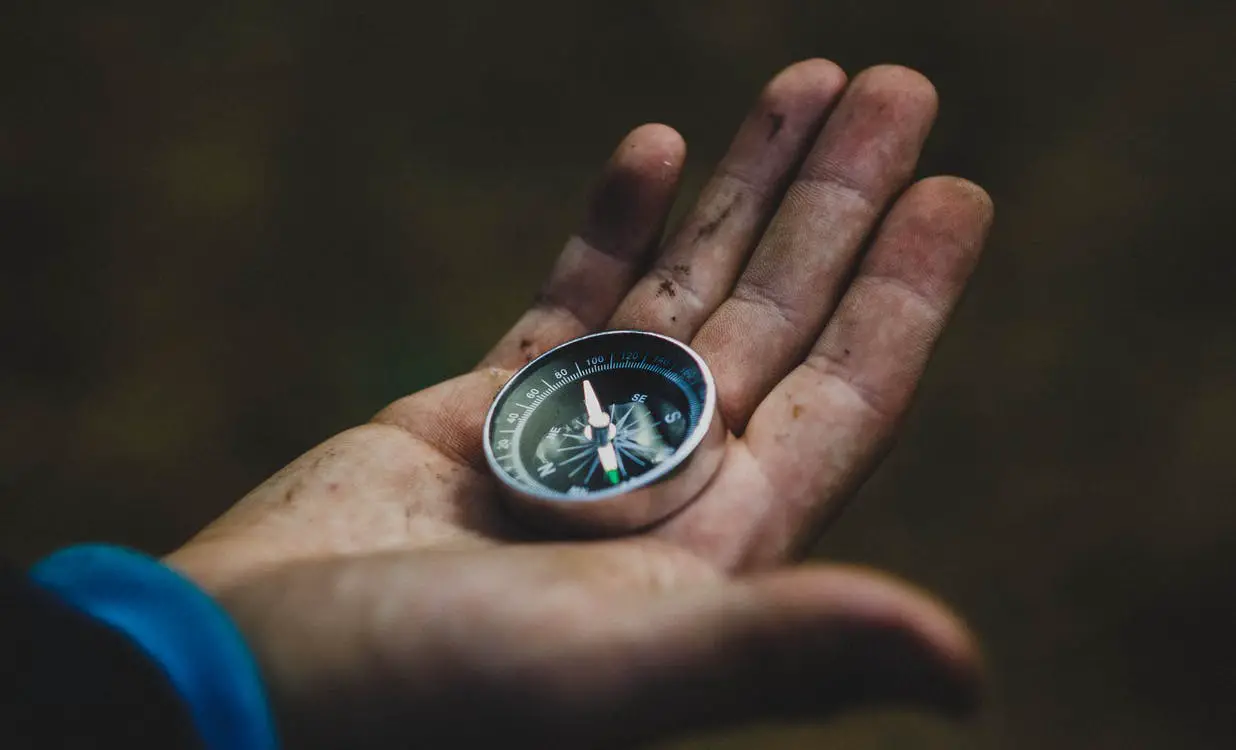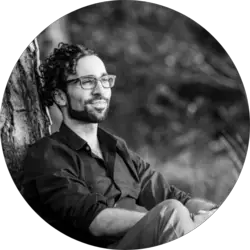![How To Deal With Sensory Overload [9 Tips For Overstimulation]](https://happyrubin.com/wp-content/uploads/2019/12/ik-ben-overprikkeld-150x150.jpg)
Logical Levels Of Bateson & Dilts [All Questions & Examples]
![Logical Levels Of Bateson & Dilts [All Questions & Examples]](https://happyrubin.com/wp-content/uploads/2019/10/logical-levels-dilts-bateson-1000x640.png)
The (neuro) logical levels of Gregory Bateson and Robert Dilts form a nice reflection model for different purposes. If you understand this model, you can achieve many powerful and beautiful results while coaching others, analyzing and solving a problem or while having a meaningful conversation. In this article you will find all about it.
Sources used: my teachers from Vidarte & Robert Dilts.
The levels in this NLP model indicate different degrees with which we can think, feel, know and speak.
- The lower levels contain trivial, concrete things and thoughts.
- The higher levels are more complex, more abstract and almost always provide more special conversations, insights and solutions.
Let’s dive right in.
Contents of this page:
The Logical Levels of Bateson and Dilts – These are all 6 levels:

The logical levels are a useful tool for many purposes. For example, they can be used to think about changes, align with conflicts, create new insights by looking at a problem from a higher level, and to make changes by level.
The Bateson and Dilts Logical Levels, From Low to High:
- Environment: external possibilities or limitations: where, when and with whom?
- Behavior: specific actions or reactions: what (are you doing well)?
- Abilities, or knowledge and skills: how?
- Beliefs and Values: Reinforcement, Motivation and Consent: Why?
- Identity: feeling of ourselves: who?
- The mission or purpose: what does it mean, for what, and for whom?
Sharp questions to get higher in the logical levels of this NLP model

Here are the right questions to move up the logical levels of Bateson.
The lowest level: Environment / Context
This is the lowest level. This is the location / context where you show it and it concerns concrete things that you can perceive.
If you work at this level, you are facilitating .
– Peter Dalmeijer
Questions to ask are:
Where, when and with whom (not)?
- Where am I?
- When do I do this?
- What can you see?
- Who am I with?
- What are you responding to?
- What is the context?
One level higher: Behavior
One level higher we find behavior. This is the only level that can be measured , and together with the environmental level, it is the only level that is visible . At this level it has to happen eventually.
You can work at this level by instructing .
– Peter Dalmeijer
Now we are already thinking in a completely different direction:
- What can I do?
- What am I (already) doing?
- How do I do that?
- What are my promotions?
- What can others perceive about me?
- What is the result, perceptible to the senses?
Up one level: Abilities / Skills / Abilities
Now we are talking about skills, capacities, talents, qualities, emotions and virtues. With this we touch a person on an even deeper level.
You can work at this level by teaching .
– Peter Dalmeijer
In addition, the TOTE analysis reveals information about this level.
It is an excellent idea to have encouragement and compliments at capacity level. For example, when people want to chase a dream, they often get criticized – and they are told not to do it. As a result, many people don’t make that big decision in the end. Suppose someone wants to go abroad to set up a new creative project, then you can address that person based on his or her capacities: ‘You seem like a motivated / dedicated / adventurous / determined person because you do. There is a lot of courage and gutsnecessary to go to a new place where you don’t know the language and have to leave everyone behind. You want to put your creativity into it. ‘
Easier ways to get information about this level – or to guide someone to this level – are the following questions:
- What can I?
- What are my skills, regardless of whether I use them or not?
- What skills, virtues, abilities and abilities do I have?
- What am I capable of?
- How can I do this next time?
- The how question.
- The TOTE questions.
- What have I learned / what should I learn?
- What are my gifts?
- What are my core qualities and virtues ?
- What moods and emotions can I invoke?
- What do you have to be able to be {Peter}?
- What do you have to be able to do to do {behavior}?
- Also ask the negative question: what can’t you do? What are your incapacities?
Make yourself FAT: Think In Capacities!
Anecdote: Although it is normally recommended to start with the lower levels when you start a conversation with someone (small talk), there was once a group of children who went to a training institute and asked unknown people on the terraces: ‘What have you got? (so far) learned today? ‘ Then they even gave a compliment! This made these people very happy. So you can certainly also start a conversation higher up the levels.
Up one level: Values (criteria) & beliefs
Another complete step higher. Changes take place most easily at this level. Convictions and values are motives and provide energy to get moving.
If you are working at this level, then you are motivating .
– Peter Dalmeijer
In addition, you can coach someone powerfully at this level if you use it in combination with the ‘consistency principle’. If you first ask about someone’s values and beliefs and then quote the desired outcome, that person will agree to the solution. The values and beliefs must therefore be relevant to the solution.
For example: “Do you think helpfulness is important? Okay, great that you think that’s important! Do you want to give us a lift, being a helpful person ?”
It is generally good to constantly ask yourself, what motivates this person?
Do you want to change behavior? Increase your values. Your standards. Your musts. Then the appropriate behavior associated with those high standards will be easily displayed.
There is also a high probability that beliefs are unconsciously present. By asking the questions of this model, you can make the beliefs aware and get them clear.
Beliefs:
- Why are you doing it like this?
- What do you believe in (about the goal)?
- What do you have to be convinced about to be able to do that? What do you have to believe in?
- What are you convinced of? Are you absolutely convinced of that?
- What are you absolutely sure about?
- (and then: how do you know? What do you base that on? For example, how do you know that it is important for people to trust their own judgment? What are the experiences on which he bases his beliefs?)
- Look for other things to track down beliefs, as explained in this article about beliefs.
Values:
- Why are you doing it? Why do you do what you do?
- What does it mean to you?
- What / who inspired you to get started?
- What motivated you to do this?
- What do you earn (to achieve)?
- What is valuable to you?
- What is it about you?
- What do you pay particular attention to?
- What does it have to meet?
- What is important to you (when it comes to target equity)? What do you find important (in context x: career, relationships, family, health, spirituality …)?
- Why do you think that is (important)?
- What’s even more important?
- What has to go right? What shouldn’t go wrong?
- Under what circumstances would you be willing not to have {criteria}?
- What do you think is the most important of all?
- What are important values for you?
- What is most important to you?
- What difference does that make? And thus?
- What do you pay attention to? What are your concerns?
- What do you find most important in life?
- What do you assume?
- What does {target equity / subject} mean to you?
- Why are you doing this, what’s in it for you?
- If there is a negative answer out, “What would you like to do instead?”
- When was that moment when you thought: Yes, I know, I’m going to (fill in)!
- What would happen if you didn’t?
- What is assumed ? So what’s ‘just standard’ without ever being asked or questioned about it?
- What keeps the spark burning and keeps you doing this every day?
- I’m very curious about something: what inspired you to become …?
- What motivates you? What motivated you to do this?
- What is your drive to continue?
- What motivates you to do x?
- What gives you {opposite of problem}?
- What brings you into action?
- Why do you want x?
- Why is it important for you to {value, eg trust} in {context}?
- What does that do to you if value A, B, C and D is there?
- If you have {all the values queried so far}, what else could cause you to leave? (The answer is also a value).
- If you got {all the values queried so far}, what else would need to be done so that you stay? (The answer is also a value).
- If necessary, put the values in order: what is most important to you? Do this nice and fast, so that the subconscious can do the work.
One level higher: Identity

The level of identity is one of the most powerful domains for moving people.
Anyone who works at an identity level is an inspiration .
– Peter Dalmeijer
However, there is something important to note about this level because it is so very high …
Of course you can use ‘identity’ at a linguistic level very well. For example to gain insights or to convince someone (“Do you want to give us a lift, being a helpful person?”). We are talking about your self-concept, or self-awareness.
However, if we take a deeper look, then you only know your identity when words stop and the self-concept ends. When we stop with words, we discover our true identity.
How you do that is through silence / meditation, after which you will find that we have confused the lower logical levels with our identity. If you then give words to your identity again, it becomes a conviction again. We will discuss this in more detail at the bottom of this article.
In the example of the previous paragraph, identity has also been mentioned: “As a helpful person, do you want to give us a lift?” Of course you can use this not only for your own interests, but also to coach someone.
What are the words after ‘I am …’ says? Those two tiny words have a powerful magic.
– Jeff Foster
Questions to go to the identity level at the linguistic level:
- What does that say about me?
- Who am I?
- What role do I play in this context?
- How do I see myself?
- What makes that Debbie?
- “Who are you with the target equity?”
- Metaphor : what do you compare yourself to? A is like B. This organization is like a tiger, because …
- Ask about character traits.
- You can identify with all logical levels: I am Dutch, I am a copywriter, I am a good student, I am a creative person, I am an atheist, etc.
Later in this article, we’ll pay extra attention to the difference between your identity as a concept and your conceptless identity.
The highest level: Mission / spirituality / connection / soul
We have arrived at the highest neurological level.
At the highest level you are an awakener and you will discover what a person contributes to the world.
– Peter Dalmeijer
The universe is bigger than identity, so bigger than any individual. Everyone is part of a greater whole, and at the same time everyone is a reflection of this greater whole.
Since mission is the highest level, this level contains the most power.
I’m not afraid. I was born to do this.
– Joan of Arc
It is a great exercise to discover how your lower levels can support this highest level and to what extent they are congruent with your mission at all. If you change this level, the lower levels will change automatically. This operation also applies to all other levels. The mission shines through everything!
The meaning of life is to find your gift, the purpose of life is to give it away.
– Pablo Picasso
It is also good to be aware of the question: can you discover your mission or can you think of your mission ? When you think about your mission, you try to stay the idea of what you want to be. This is a mis-match with yourself. When you discover your mission (which cannot be expressed in words), you become aware of what you already did. You can express this and that leads to congruence and spiritual development.
What is your essence / heart wish / desire? Your mission feeds you, was there for you and goes much further / deeper than you!
- Why (are you in this world)?
- What was your motivation for what you did it for?
- What did you want to contribute by doing that?
- What is my goal?
- What is my effect on others? What do others ask of me?
- What do you want to mean for your environment?
- What’s your dream? Calling? What dream am I carrying out?
- What does your light turn on? (Suppose you were a lamp)
- What are you coming to bring us?
- Who else am I serving as a congruent person?
- What is my mission?
- What is the vision I live by or represent?
- What is the bigger picture from which his inspiration comes? ”
- What is the meaning of your life?
- What do I want to mean for the environment I am part of?
- What do you contribute to the world?
- For what greater purpose am I doing this?
- From which larger framework do I act?
- What am I accomplishing?
- What is my meaning?
- Imagine this is the last day of your life. Ask yourself: Have I lived? Did I matter? Have I given love? Open, fair and generous? Or did I hold back everything?
It is about becoming a pure channel that produces the beauty that is meant to move through you.
General questions to get ahead

Use the upchunk questions in the article on chunking, draw inspiration from it and improvise yourself to lead someone higher up these logical levels, for example in your NLP coaching. You could also call this process of climbing the logical levels ‘upchunken’.
The superlative of this reflection model: vision
When you make a synthesis of identity and mission, you create your vision. If you are in touch with your identity and mission, you can concretize this through meditation and visualization (= vision). In this way, you detach from your ego and follow your congruent path.
More about how Bateson’s logic levels work
A number of other things are mentioned below about the operation of this Bateson reflection model.
- The higher the level, the greater the influence it has (on the lower levels). So be aware of this if you want to convince and influence someone . So the top level – mission – has the most influence. “He who has a reason to live can endure almost all living conditions” (Nietzsche) and change. Viktor Frankl discovered during his imprisonment in Auschwitz that the prisoners who could no longer experience meaning in life were the first to be doomed.
- A solution is often not at the level where the problem is discovered, but at a different level.
- Lower levels are easier to change than higher levels.
- The levels depend on each other.
- If you change something at a lower level, it may lead to a change at a higher level. If you change something at a higher level, it always leads to a change at a lower level.
Most common uses of the logic levels

Every behavior has a positive intention. For example, a smoker wants to relax and gets that relaxation out of a cigarette. An alcoholic wants to forget his heartbreak. When this behavior does not satisfy the underlying need, it can be taken to a higher level.
What are your goals? Who are you? What is your real need? Then go back to a lower logical level and satisfy that need by positively changing the behavior or environment. This is called ‘lateral chunking’. A practical technique for doing this is the 6-step reframing.
For example, if the value ‘friendship’ was previously satisfied by smoking together, the behavior ‘smoking’ can jump to that higher level of ‘friendship’. When thinking about friendship, it can be concluded that other activities such as watching football together or drinking tea together also give substance to it.
This process of lateral chunking (first upchuncking, and then finding another downchunck example) is very useful in mediation and negotiation . You are jumping from a specific behavior of friendship, smoking together, to a greater understanding, friendship itself, to then come back to specific behavior that also gives substance to the value of ‘friendship’.
Some other uses of the logic levels:
- The logical levels are a useful analysis tool for a situation or a problem, by gathering information at all levels.
- You can lead another, by means of questions, to other logical levels so that you get more information: you explore and broaden the world view.
- When the levels are equal, you can also speak of congruence . You can also investigate this with the logical levels.
- It is a conversation techniques tool for starting conversations with people . If you are starting a conversation with strangers and asking open questions, go up from the bottom of the pyramid in order. This way you get distinctive conversations that arise naturally and you get more variety in your conversations.
- It can be used for feedback : “Your identities are all excellent but have you had behavioral problems with the practice?”
- In conflict it can be thought that behavior does not make a person who he is.
- Conflicts can be resolved by switching logic levels. This is applied in the NLP negotiation model, which is also a mediation technique.
- Inner conflicts can also be resolved by looking at the higher logical levels. For example with the technique: ‘ Negotiating with parts’, or ‘Parts Integration’.
- You can connect with people at the logical level at which they are communicating, to make a connection with that person ( report ).
- You can motivate and influence people effectively by addressing them at their higher logical levels.
Two reading tips: Practical books about working with the logical levels
The practical book ‘Change your beliefs’ by Robert Dilts goes further into this topic. In addition, ‘Coaching from a multifaceted perspective’, also by Robert Dilts, is the book that presented the logical levels in a currently widely used coaching method.
Exercise: Recognizing the Logical Levels of Bateson and Dilts
A tells something impressive that he recently experienced. B and C listen and discover at which logical levels A gave the information.
Also do this once while listening to interviews on radio, TV or a conversation. Which logical levels do the discussion partners use?
Exercise: Acquire skill in recognizing the logic levels of Bateson and Dilts
A comes up with two or three sentences. B and C listen and discover at which logical levels A gave the information. Repeat this several times to get familiar with this.
Exercise: Climbing the Logical Levels (Climbing the Pyramid)!
A tells about an experience. B listens and asks questions and provides summaries that are aimed at always leading A to a connecting / higher logical level. The goal is to get information at all logical levels. This is a handy analysis tool, and it also makes a conversation more meaningful.
Exercise: Using the levels ‘in the wild’ as an analysis tool
Ask someone to discuss a problem with you. Analyze this problem using the logic levels.
Then ask this person what beliefs he / she has about the topic. Find out at what logical level these beliefs are (‘This belief is at the level of …’}.
Exercise: your desired identity
- Determine your desired ‘identity’ (which is actually a role).
- Make a representation of this desired identity: what does he think, what are his emotions, physiology, what (strength) questions does he ask himself? etc.
- What do the logical levels look like in the light of the desired identity?
- Live this new identity for a whole week!
Exercise: Using the logical levels as a consultation tool
- Map the logical levels of an organization with which you are connected.
- Also involve yourself: how can you be part of this organization in an ecological way or not?
- If necessary, give advice for this organization, aimed at making the logical levels more congruent.
- Also give advice for recruitment and selection, using the logical levels of the organization.
Intervention: making the logic levels congruent (Logical Level Alignment)

Do you feel that you have incongruent behavior, or do you feel insecurity, lack of capacities or a restrictive feeling? Then do this intervention.
- Determine what a context of yours is in which you want congruence. This is, for example, a goal that you have set.
- Line up the logic levels on the floor.
- Start with environment and work your way up to mission / spirituality: you always take a step forward to get to the next logical level. At each step, answer the corresponding questions related to your situation in which you want congruence. So it is about the current situation.
- At the highest logical level, you anchor the feeling after answering your questions. As you fire that anchor, you walk back to each lower level. Always ask questions such as: ‘Take your physiology and inner experience to the identity level and notice how it strengthens or enriches your previous representation of your identity experience … (…) how it strengthens, changes or enriches your capabilities … Etc. Your {higher level} is expressed in {lower level}.
- When you are done, you reflect: where is the change for you? What will that bring you? Is my behavior, abilities, beliefs, values or identity currently inadequate / ineffective?
Variations: you can do the above technique with all kinds of contexts in your life. For example with your goal, with your problem, with your current situation or with your best self. You can also fully integrate the levels by going through them several times, going backwards and by naming them from the meta position.
Let’s delve deeper into the logical level of identity

The Bateson Logical Levels are a very practical tool, but the two highest levels are actually very deep layers. Take the identity level for example. Is it possible to be yourself and know your true essence? Let’s take a deeper look into your pure essence.
Identity level? In life we have roles (and what you have you can’t be)
We always have a role in our lives. Each role consists of a combination of all lower logical levels: values (criteria) , beliefs (beliefs) and a self-image, linked to capacities, behavior in an environment. The more roles we have, the richer our lives are.
The moment we can switch roles smoothly, we have created an ideal situation. But most of the time we are stuck in certain roles … We say: that’s me! We then say: I am a student, colleague, husband, etc. But is that really who you are, or are those roles that you have?
Be yourself. There are so many others already.
Loesje
You have sub-personalities and roles. What you have, you are not. By learning to let go of roles, I am creating a richer life, a fundamental aspect of personal growth. Who you are is the consciousness and essence behind those roles.
Life is a masquerade ball: the bigger your suitcase, the more you can play. ‘Persona’ is another word for mask. Learn to play your roles as a good actor. The actor is more than all his roles.
“I am X” is the greatest complex equivalence in your life.
However, we identify with our roles, whereas roles are temporary

Well, now we know, “I have a role, but I am not!” Unfortunately, it is not that easy to live by. For the roles we want, it is difficult to step out of identification, to realize that we are not them.
At some point you have to be able to let go of the role of mother, or father, for example, for the growth of the children. It is not that if you have the biological capacities to bring children into the world, you still have the capacities to raise the child at a later point in time. The child can become physically healthier than the parents, which means that the roles of caregiver must be reversed.
The past does not equal the future.
– One of the NLP principles (assumptions)
Another kind of example: an important aspect of motherhood is to provide protection. Children cannot stand in their own strength if mother cannot stop this protection, even at a later age. Then children do not get around to developing the protection within themselves. Then you are strongly identified with the role of mother and you cannot let go of that. So a pitfall is to attach ourselves to our roles, through that identification.
This false identification takes place on all kinds of logical levels

You can identify yourself at different logical levels of Bateson, for example at the level of environment. For example: I am Dutch. Without identification you experience it more like: I was born in the Netherlands or I live in the Netherlands.
There is also identification with cities, neighborhoods, etc. Identification makes others a threat. If we can say: we are who we are, and there is only a difference of place (you live in Amsterdam and I live in Rotterdam), then there is more freedom and enemy thinking disappears.
The logical levels of behavior (doing) and capacity (being able to) can be mistaken with who you are. Anyone who is aware of this knows: I am who I am and I do what I do. I do not limit my ‘being’ to a behavior, I am more than what I do: I am not my behavior, I am much more than my behavior.
If you have an identification at the level of ability (capacities), then you are nothing when you cannot do something. Then you are nobody. You are going to reject yourself before someone else does. Self-rejection is a lot less painful than getting rejection from the other. However, you will never be fulfilled.
Instead of saying, “I’ve failed and I feel bad,” many say, unfortunately, “I’m a failer.”
For example: in the shop, an employee offers a child a slice of sausage. Mother then says: ‘Did you accept that? Shame, you can’t accept a slice of sausage! ‘ The child will then say no to a slice of sausage the next time, even before mother can say ‘no’ and so we block our capacities and possibilities. If that child at that time and in his life identifies its capacities and capabilities, he will have a hard …
Or take the example of a painter who is identified at capacity level: “I am what I can do.” One day his painting abilities fall away, he thinks: “I am nothing anymore.”
Belief-level identification is also an insidious one: “I am what I believe!” Or “I am what I think!” You see that a lot in people who adhere to ideologies, such as: I am a Muslim, Christian, etc. Instead of: I choose this religion or this way of giving meaning. Then when there is a discussion, there is a sense of personal rejection, because the believer is attached to it with his identity. If someone disagrees with what he believes, he thinks, “He rejects me .”
This is also the case with party politics with a certain ideology. You can no longer think for yourself, and the ideology indicates your school of thought: ‘thinking differently’ then means: being rejected. This false identification (with country, city, district, religion, job, etc.) makes the other person a threat.
Why should I detach from that identification with roles and lower logical levels?

We are stuck in roles. An unhealthy example of this: we take the role of director at work into our lives at home, for our family, for our friends, for our neighbors and for our dog. So know where your role starts and where it ends, and where the next one begins. In this way, the quality of each role is also enhanced.
We cannot do without roles, we always need an interface. By being able to let go of a role and being aware of where a role begins and ends, you can fulfill the role more consciously and with more quality. By letting go of the role, I get better at fulfilling the role.
Of course you remain biological father or mother, but you have to know where the role begins and ends, and distinguish between yourself and your role. You are much more than the role. We fulfill some roles, and we merge some roles. Sometimes we squeeze ourselves into a roll, as if we have to. By letting go of that, we get expansion and freedom.
I am not my mind, intellect, ego or memories. I am not my organs and body parts (ears, tongue, nose, eyes, skin, speech organ).
Make a distinction between ‘self’ and ‘role’. You are much more than that role. So “that’s how I am” is limiting. Better, “I have … {lower logical levels}” You are the consciousness behind the roles. So say, “I have the roles {ABC}” Instead of, “I’m a director.” Each role in life is valid for a specific time.
From a biological point of view you will of course remain a mother, but you will not keep the role of mother forever. Sooner or later you can lose everything you have. So you are not: your job, your religion, your body, your gender, etc. On the other hand: you cannot lose what you are . That is spiritual awakening : You awaken from identification with roles, thinking, forms, matter, etc.
Things have happened in the past, but that’s not who you are. The mind makes you believe so, because it does reinforce the feeling of ‘I’.
Meet people you know without meeting them or your past. Don’t meet them as a running personal history. For example with your family members. When you think about a person’s conditioning, so his or her past, you think you are interacting with other people, but there is no one there, just a bunch of conditioning (actually a big bunch). There is nobody home. That’s not who they are. What you can’t think about in the other person is who they are, and that’s who you are.
Don’t meet people as a running personal history.
– Eckhart Tolle
Who am I? You know that! – You can’t put that in words

You can put the lower logic levels of Bateson in words. You really can’t put the highest two logical levels of Bateson into words …
Bateson’s lowest four logical levels are about “having.” I have: behavior, capacities, beliefs and values. They all have something verbal : you can put words to them. However, ‘who am I’ can never be described, cannot be defined and never fully comprehended.
It’s okay if you ask yourself what you want from life, but a more important question is, What does life want from you? What does life have in store for you? You will find out if you allow the silence into your life. Then you hear the wordless signals from life that want to help you in the search for your life purpose. ‘
– Eckhart Tolle’s response to Oprah Winfrey when she said, “I don’t think there’s anything more important than realizing your life purpose.”
The question is: Who am I? I have values and beliefs. I have no identity, I am that person. I don’t have an identity, but I am! Now you might assume the identity of, say, a student, which is actually a role. Who is the one behind all those roles?
It is difficult to get in touch with essence and pure energy without language and thought intervening. The Tao Te Ching says, “If you can talk about it, it isn’t.”
Who am I? This is an essential spiritual question. Can that question be answered? That is a good question. There is no verbal answer, but it is an experience of being yourself .
When you are there, you will know. We want to feel it so badly. And then in every aspect of our daily life. Being yourself is a fundamental paradox. The words and needs disappear, you can’t explain it anyway. If you are, then you know! You are meant to become who you are meant to be. That’s your potential. You can actualize this at the level of meaning : a logical level higher than your identity …
The question ‘Who am I?’ answers all questions. Go to the Amazon for 8 weeks and ask yourself this question.
Bateson’s mission level: express your purpose, then you know who you are
The essence is already there, now come out with it! You learn who you are by expressing your essence. All those expression possibilities support your self-realization. You have behaviors that support your expression. Every form of your expression is a reflection of who you are.
The highest form of art is the art of living. To live according to how your life is meant to be, that is an art. The destination is who you are. A tree can only be a tree, a cat is a cat. However, man is not capable of being who he is meant to be at all.
Think about yourself: when you are yourself, you feel free, loving and compassionate. Someone who is himself is not going to lecture others. You can lose everything you have (values, beliefs, capacities, behavior and environment) and you are not.
On the level of identity, you have always been who you should be and you always will be.
A painter looks for maximum expression of himself by painting. By expressing himself through painting, he evolves and becomes even more of who he is. A painter starts painting in order to achieve maximum expression. By evaluating that and keeping that flow going, over and over again, he becomes a better painter and can better express what he means and express who he is.
Now let’s look at the logical levels with different eyes

Take the logical levels of Bateson and Dilts for yourself.
- Environment is an expression / effect of my behavior or behaviors.
- Behavior is an expression of my abilities.
- Capacities are an expression of my thinking (beliefs and values).
- Thinking (beliefs / values) is an expression of who I am.
Whose expression are we ourselves? If we are someone, where do we come from? We can only have emerged from consciousness . We are an expression of a higher consciousness .
Mission, which is beyond identity, is essentially our cosmic identity. Our mission is bigger than ourselves. It controls our lives , if we choose to. Our mission is an expression of higher consciousness. Our mission is to serve the most precious.
Buddha, Christ, Bahá’u’lláh … Some of the many manifestations that refer to what we are an expression of, what directs our lives when we choose, to find an answer to ‘who am I’. In order to find an answer to the question “What am I myself an expression of,” I wonder what is the greater “self” of which I am a part.
That means the mission that is above me is not who I am. What we bring to the other is who we are. We are the present ourselves . This is difficult to understand when your self-image is low, but your self-image is not who you are. Who you are is an expression of higher consciousness of pure love, freedom, peace, compassion and being yourself. You cannot actually describe this with words, but people do make attempts in different ways: our cosmic consciousness, God, love, unity …
I am not an environment, I have an environment. I am a mission, this is the only identification that is valid . The jewel in the heart of the lotus.
The two highest levels, identity and mission, transcend the verbal. Rather, they are experiences, or feelings: things you feel and know. This is trans-verbal: you cannot describe it in words. If you are, you know. People write songs, poems, books, etc. about it, but that only points to it. A poem about this is not ‘it’. It’s about it. And the special thing is fortunately: when we are there, the need for explanation disappears.
The paradox: you don’t have to be yourself at all in this life
You don’t really have to be yourself. You are yourself when you are dead. Now, in this earthly life you can actually start doing things, instead of just ‘being’. At the same time it is true that when you ‘are’ you can do the most cool things. So it is a paradox. Trump, Obama, big stars who have accomplished something, they have also used an act: they were not themselves while putting their performance through their act. Otherwise they wouldn’t have gotten that far. Use it ‘(the act / tools).
You may have trouble with this. You should allow that imbalance (between what I am and my act), because everything that is in balance stands still: there is no growth. Moreover, people do not start to “discover themselves” until their last few years of life. Until then, you can build the experiences that make you that person, and then be yourself completely when you die.
We are part of a greater whole (that has put His likeness in us)

We are both part of nature and part of an even greater whole. Because we are part of nature, we want to take good care of this. You are also part of the greater whole of the universe. And that greater whole has something special ahead of us: it has put its own qualities in us. Each of us has the energy that is large enough to make the visible universe visible. We are effective creators. Read more about this in the article on non-duality.
Your individual needs and the collective needs are congruent and make a perfect marriage. Because we are not separate from each other.
This world is a school for learning to ‘die’. Don’t literally die, but die for everything we all are not. Dying is letting go of the 4 lower logical levels – all levels below the identity level – to create new possibilities (being born again in Christ: in a Christ consciousness). Your identity remains. In this way, our life is a school to be able to die consciously.
The top two logical levels (identity and mission) have to do with freedom, spirituality, consciousness, timelessness, transverbality and pure energy. As discussed earlier, you cannot put this into words. The bottom 4 logical levels have to do with bonding, with time, material: the form that we take for a certain period and then let it go.
Logical Levels of Bateson … Being Yourself: Exercise – “I am!”

The following exercise is a practice of Buddhist monks. First they write down and musing on all the roles they have, and then they deny.
- Name 20 different roles. A role is not quality. A role is something you can give to an actor.
- Take a moment to connect with the internal state of the role. Roles that require time and investment have the best effect in this exercise.
- All other members of your group have your list of the 20 roles, and you don’t have your list.
- First, take a break. As a result, you no longer know exactly in which order the roles are. You have also lost a number of roles.
- Make a circular arrangement. You are in the middle.
- The group members name a role in no particular order. Divide these roles: 1. Who starts by naming the first role; 2. Who names the last role; 3. Who asks the question: who are you then? You do this as follows:
Group member: “First name (……), you are… (name the role) and make eye contact.”
Subject: ‘No, that’s not me, that’s just a role that I can play for a while.’ You say this regardless of what you feel about it. The stronger you identify with a role, the stronger the resistance to your own statement.
Immediately after all 20 roles have been named, someone asks the last question:
Group member: ‘Who are you (without eye contact)?’ Subject raises what is happening, feels and takes the time to experience what is happening. You cannot directly experience what is happening, your mind is switched off for a moment. Sometimes there is an experience of expansion, sometimes intense grief (“I cannot be myself, I am!”). Sometimes a person loses balance. Let it happen. Let what happens. Examples of roles: father, son, brother, son, student, teacher, entrepreneur, handyman, etc.
So: fulfill your sense of purpose, and thus become yourself!

We are angels ourselves going through a physical experience. Ask yourself the right question, am I the angel I would like to be touched by? How would I like to be affected? The quality of the energy with which we move has a direct effect on our environment. Look through the pain and misery and focus on the light: that is love.
At first you do not develop for yourself. But as a service to the world. The best service you can render to the earth is to grow so that others can grow too. You can do this by introducing quality of consciousness. Service without ego, need and at the service of the other.
“The most evolved is the greatest servant” – Christ.
Read further? Practical book about working with the logical levels (tip!)
The practical book ‘Change your beliefs’ by Robert Dilts goes further into this subject. In addition, ‘Coaching from a versatile perspective’ specifically zooms in on how the logical levels fit into a coaching context.
Neurological Levels of Dilts VS Logical Levels of NLP
It’s important to note that there is a big blame against Dilts neurological levels as they can impose content on a person. And when that happens, we don’t speak of pure NLP. For example, not everyone believes in a spiritual mission, while the neurological levels dictate it.
The original logical levels of NLP, on the other hand, are completely content-free: they are just a way to organize content and a way to navigate through content. This is also called chunking . Chunking allows you – just like Bateson’s Neurological Levels – to navigate from concrete to abstract, but without implying content.
The logical levels of Bateson / Dilts are in any case covered in many NLP Practitioner and Master Practitioner Training Courses.

![5 Best Self Care Tips For College Students [#1 Advice]](https://happyrubin.com/wp-content/uploads/2021/09/the-best-self-care-tips-for-college-students-440x264.jpg)
![How To Stick To New Year’s Resolutions: 9 Tips [Smart & Sure Ways]](https://happyrubin.com/wp-content/uploads/2019/12/tips-voor-goede-voornemens-440x264.jpg)
![How To Stop Being So Hard On Yourself [9 Great Tips]](https://happyrubin.com/wp-content/uploads/2019/12/we-moeten-zoveel-van-onszelf-en-anderen-150x150.jpg)

![19 Best Ice Breaker & Get-To-Know-Eachother Games [Fun & Simple]](https://happyrubin.com/wp-content/uploads/2018/02/leukste-ijsbrekers.jpeg)
![Becoming More Social: 41 Tips [Improving Social Skills] [List]](https://happyrubin.com/wp-content/uploads/2018/06/sociale-vaardigheden1.jpeg)
![How to start a conversation with anyone: 15 tips [Making contact]](https://happyrubin.com/wp-content/uploads/2017/08/gesprekstechnieken1.jpeg)
![372 Friend Tag Q&A Questions [Best Friend Quiz]](https://happyrubin.com/wp-content/uploads/2019/05/best-friend-tag-vragen-voorbeelden.jpg)



![Clingy & controlling behavior of partner/date [Extreme examples]](https://happyrubin.com/wp-content/uploads/2020/06/claimerig-gedrag-van-partner-eigenschappen-en-voorbeelden-150x150.jpg)

![How to recognize if a man is in love [Signals & his body language]](https://happyrubin.com/wp-content/uploads/2020/05/verliefd-gedrag-van-mannen-herkennen-150x150.jpg)


![Free will and religion / theology [Verses & Quotes on free will]](https://happyrubin.com/wp-content/uploads/2020/10/religion-on-free-will-quotes-1050x640-1-150x150.jpg)

![Dealing With Setbacks & Hardship [Lessons & Examples]](https://happyrubin.com/wp-content/uploads/2018/11/omgaan-met-tegenslag-tips-hoe-dan.jpeg)
![NLP Agreement Frame: Use these exact sentences [Examples]](https://happyrubin.com/wp-content/uploads/2020/10/agreement-frame-nlp-1125x640-1-440x264.jpeg)
![122 Best Comebacks In Any Situation [Best Examples]](https://happyrubin.com/wp-content/uploads/2020/06/beste-comebacks-technieken-tips-440x264.jpg)
![Using Hypnosis to Stop Smoking [HowTo]](https://happyrubin.com/wp-content/uploads/2020/05/stoppen-met-roken-door-hypnose-150x150.jpg)
![Presuppositions language pattern: meaning & examples [NLP]](https://happyrubin.com/wp-content/uploads/2020/04/wat-zijn-vooronderstellingen-150x150.jpg)
![Peripheral Vision: Meaning & Exercise [Essential Skill]](https://happyrubin.com/wp-content/uploads/2020/04/perifeer-zicht-trainen-tips-150x150.jpg)

![How To Start A Coaching Business [21 Smart Tips]](https://happyrubin.com/wp-content/uploads/2018/11/coachingpraktijk-starten-tips.jpeg)
![How to make dreams come true? [33 tips to realize dreams 100%]](https://happyrubin.com/wp-content/uploads/2018/05/dromen-mijlpalen.jpeg)
![How To Become Rich? 27 Millionaire Tips [Guaranteed To Work]](https://happyrubin.com/wp-content/uploads/2018/01/hoe-kan-ik-rijk-worden.jpeg)
![77 Best Online Marketing Tools [Recommendations] [Also Free]](https://happyrubin.com/wp-content/uploads/2018/08/beste-onlne-marketing-tools-tips.jpeg)
![Complete List Of Virtues & Qualities [Including Explanation]](https://happyrubin.com/wp-content/uploads/2018/12/kernkwaliteiten-uitleg.jpeg)
![Being Attentive: How Do You Do That? [Meaning & 9 Tips]](https://happyrubin.com/wp-content/uploads/2019/05/attent-zijn.jpg)
![Being Conscientious: Meaning Of This Virtue [Explained]](https://happyrubin.com/wp-content/uploads/2018/07/Consciëntieus-persoon.jpg)


![Best Books About Burn-Out [Top 10] [Update 2025]](https://happyrubin.com/wp-content/uploads/2020/06/beste-boeken-over-burnout-lijst-440x264.jpg)
![Best Self-love Books [Top 10] [Update 2025]](https://happyrubin.com/wp-content/uploads/2020/04/beste-boeken-over-zelfliefde-aanraders-440x264.jpg)
![Life changing books: 10 books that change your life [2025 Update]](https://happyrubin.com/wp-content/uploads/2020/03/levensveranderende-boeken-tips-150x150.jpg)
![Top 10 Best Books: Recommendations Per Genre [2025 Update]](https://happyrubin.com/wp-content/uploads/2019/12/best-books-per-genre-150x150.png)
![Best Books On procrastination: Must Reads [List] [2025 Update]](https://happyrubin.com/wp-content/uploads/2019/11/beste-boeken-over-uitstelgedrag-tips-150x150.jpg)
![Joe Dispenza: Events To Attend [2025 & 2026] [All Info]](https://happyrubin.com/wp-content/uploads/2020/02/joe-dispenxa-events-440x264.png)
![Best Online Study Options [Online Education Top List]](https://happyrubin.com/wp-content/uploads/2019/03/best-home-study-options-440x264.png)
![Teachable Review & Experiences 2025 [Bad Online Training Tool?]](https://happyrubin.com/wp-content/uploads/2020/02/Teachable-review-ervaringen-150x150.png)
![Audible Review, Experiences & Special Discount [Scam?]](https://happyrubin.com/wp-content/uploads/2020/01/audible-review-ervaringen-150x150.png)
![Guest Posts Wanted [Free & Always Directly Accepted]](https://happyrubin.com/wp-content/uploads/2019/05/gastbloggen-regels.jpg)

This is an amazing site! Amazing, amazing and amazing!
Thank you very much for your hard work and generosity.
I am learning a lot
People like you make this world a better place
I became a formally accredited NLP master practitioner/trainer candidate about a quarter of a century ago. I decided* today to review “logical levels”. I am also currently “studying”, informally, non-dualism – “exploring” might be a marginally better word than”study”.
[*What led to the decision was that I have a friend who has recently deepened her relationship with “God”, and is now openly evangelical. She wanted to know whether I had changed my previously indicated atheistic belief, and if not why I held that belief. Btw, I don’t wish to change hers because it appears to be working for her. Also, I have no inclination to change mine – hell, wherein I am in her world view destined to end up forever will likely freeze over first. But I have a desire somehow to communicate that to her and for us to remain friends.]
The above article is to “my” mind very thoroughly and convincingly explained, and is among the most useful internet pages about NLP that I can recall reading, So much of it concurs with “my” own experience as I approach 80 years of age with body and mind still functioning well (especially the latter).
I particularly liked this. “At first you do not develop for yourself. But as a service to the world. The best service you can render to the earth is to grow so that others can grow too. You can do this by introducing quality of consciousness. Service without ego, need and at the service of the other.” That accurately describes my bi-directional experience of the last 30 years.
I’ve enjoyed reading your summary, bit am puzzled by why all the photos in this article are of attractive white women in their twenties or early thirties. This seems to promote a particular bias whether conscious or unconscious about who is happy, what happiness looks like, and where it can be enjoyed.